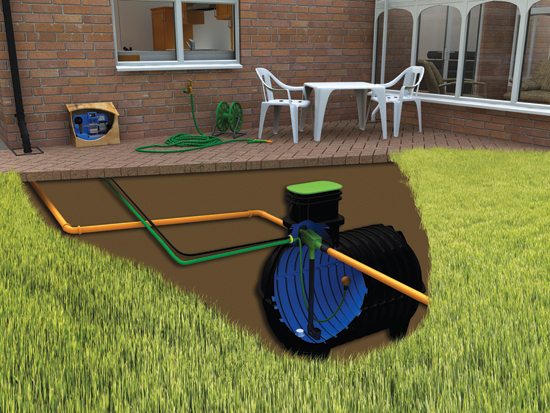Rainwater harvesting explained
All you need to know about rainwater harvesting as expert Richard Eddy, from Polypipe shares advice and answers FAQs

Looking for an eco-friendly and cost efficient way to improve your home? Richard Eddy, below ground drainage product manager at Polypipe shares advice and knowledge on rainwater harvesting.
What is a rainwater harvesting system? How does it work?
Rainwater harvesting systems provide your home with the ultimate in water recycling capability by offering a sustainable solution to the challenge of conserving scarce resources and reducing the rising cost of water. The systems distribute cleaned and filtered rainwater to a variety of non-drinking applications in and around the home. The average household in Great Britain now uses 349 litres of water every day, according to figures published by the analysis of responses to the Energy Saving Trust's Water Energy Calculator. As water prices continue to rise, using this amount of water doesn’t just increase your carbon footprint, it’s expensive too. Luckily for us, rainwater harvesting makes it easy to reduce the amount of water we’re using, and in turn, help us make some welcome savings.
How can rainwater be used in the home?
Non-drinking applications such as car washing, toilet flushing or garden watering account for more than 50 per cent of domestic water consumption, meaning the potential savings are huge when the water used for these tasks is replaced with rainwater.
You might not think it, but your toilet is the appliance which consumes the most water in your home, making up around 30 per cent of mains water usage. So by using rainwater for flushing alone, you could make a real difference to your bills. Washing clothes is another culprit, accounting for around 13 per cent of domestic water use.
Many of us don’t realise that it’s both possible and perfectly safe to use rainwater in washing machines, rather than the mains water. Another benefit in using rainwater to wash clothes is that it’s naturally ‘soft’, meaning not only is less detergent needed but the machines are less susceptible to scaling.
You can also use stored rainwater for jobs outside the home such as washing the car or watering the plants during dry periods, meaning your garden can flourish whatever the weather (and be the envy of your neighbours during hosepipe bans!).
Can I use water from the system for cooking or washing?
It’s important to remember that while rainwater harvesting systems filter the water to a level suitable for non-drinking applications, you should not use it for cooking, drinking or showering.
Get small space home decor ideas, celeb inspiration, DIY tips and more, straight to your inbox!
Where is the rainwater harvesting system installed?
A rainwater harvesting system takes up less space than you might think and can be installed relatively easily. The storage tank used to collect the rainwater is buried underground so it won’t spoil the appearance of your garden or block spaces such as lawns or driveways.

How does the rainwater harvesting system collect the water?
Downpipes collect water from the roof of your home and pipe it into the tank. Once in the tank, it is then filtered to remove unwanted matter such as leaves, before being pumped into your home, ready for you to use. How does the water reach the appliances in my home?
The water can reach your home appliances in one of two ways. It can be pumped to a header tank in your loft and then taken to each appliance by gravity (an indirect or gravity-fed system). Alternatively, you can opt for a pressurised system (direct system) which uses a pump to directly send water to your appliances as and when you need it.
How much water can a system hold?
The size of tank will be dependent on the size of your home, how much water you need and what you’ll be using the water for. Tanks range from a relatively small 1,000 litre capacity, up to 10,000 litres.
What if it doesn’t rain enough to fill the tank? Although this is unlikely to be a concern in the UK’s climate, most rainwater harvesting solutions do include a control system which monitors water levels and reverts back to the mains water supply if necessary. This measure ensures applications never run dry, so you won’t be left with a toilet that won’t flush or no way of washing your clothes.
Is a rainwater harvesting system suitable for my home?
Thanks to innovation in the rainwater harvesting market there is now a solution available for most homes. The only real requirement for installation is that you have a garden large enough to accommodate the tank and its associated parts, such as the pump. For expert advice on what system options you have, contact an installer or system manufacturer directly.